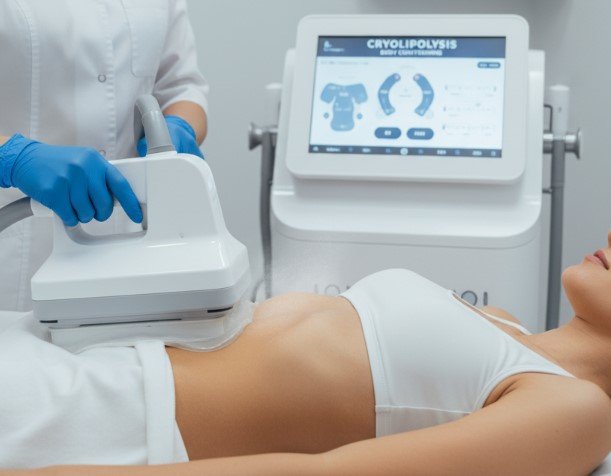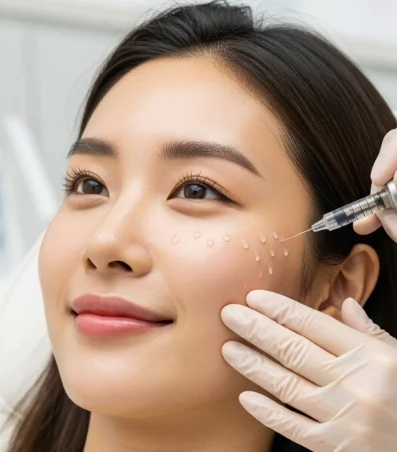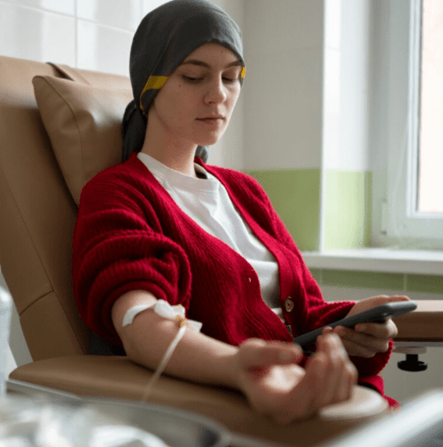Treatment Overview
Carboxy Stretch Mark Therapy is a minimally invasive treatment that uses medical-grade carbon dioxide (CO₂) gas injections to improve blood circulation, stimulate collagen production, and repair skin affected by stretch marks. By delivering CO₂ just beneath the skin, the body responds by increasing oxygen supply and activating fibroblasts, which helps fade stretch marks, tighten lax skin, and restore elasticity.
In Korean dermatology clinics, Carboxy Therapy is widely used on abdomen, thighs, buttocks, breasts, and arms, especially for patients with post-pregnancy stretch marks or skin laxity after weight changes. It is often combined with microneedling RF, lasers, or mesotherapy for enhanced stretch mark correction and tightening.
Purpose & Benefits
- Stretch Mark Reduction: Improves texture and fades red, purple, or white marks.
- Skin Tightening: Stimulates collagen and elastin regeneration.
- Improved Elasticity: Firms thin, crepey skin.
- Enhanced Circulation: Increases oxygen and nutrient delivery to skin.
- Dual Benefits: Addresses both texture (marks) and laxity (tightening).
Ideal Candidates
Carboxy Stretch Mark Therapy in Korea is recommended for:
- Patients with red, purple, or white stretch marks on the body.
- Adults with loose or sagging skin on abdomen, thighs, buttocks, or arms.
- Post-pregnancy patients seeking non-surgical stretch mark repair.
- Individuals combining treatment with Fraxel, RF microneedling, or mesotherapy.
- Those preferring gradual, natural improvements.
Possible Risks & Complications
- Mild Pain or Tingling: Common during injections, subsides quickly.
- Temporary Redness or Swelling: Usually fades within hours.
- Bruising: Possible, especially in sensitive areas.
- Variable Results: Stretch mark depth and skin type affect outcome.
- Not Suitable For: Pregnant women, patients with severe vascular or clotting disorders.
Surgical Techniques Used
- Carboxy Injections: CO₂ gas delivered with fine needles into the dermis.
- Key Mechanisms:
- Oxygenation Boost: Increases blood flow and tissue healing.
- Collagen Remodeling: Stimulates fibroblasts for firmness.
- Tissue Renewal: Improves skin thickness and resilience.
- Combination Therapy: Frequently paired with RF microneedling, laser resurfacing, or mesotherapy ampoules.
- Protocol: 6–10 sessions spaced 1–2 weeks apart, with maintenance every 6–12 months.
Recovery & Aftercare
- Immediately: Mild swelling or pressure sensation.
- 1–2 Days: Skin returns to normal; slight tenderness possible.
- After Several Weeks: Stretch marks lighten, and skin feels firmer.
Aftercare Tips:
- Avoid strenuous workouts, saunas, or hot baths for 24–48 hours.
- Keep treated skin moisturized with hydrating creams.
- Apply SPF 50+ sunscreen to prevent pigmentation.
- Maintain healthy hydration and diet to support collagen repair.
Results & Longevity
- After 1–2 Sessions: Skin feels smoother, with subtle improvement in marks.
- After 4–6 Sessions: Noticeable fading of stretch marks and improved elasticity.
- After 8–10 Sessions: Significant tightening and visible stretch mark reduction.
- Long-Term: Results last 6–12 months; maintenance boosts longevity.
Treatment Process in Korea
1. Consultation & Skin Analysis
- Dermatologist evaluates stretch mark depth, skin laxity, and patient goals.
- Custom protocol created, often combined with boosters or lasers.
2. Preparation
- Skin cleansed; numbing cream may be applied.
3. Carboxy Therapy Session
- Step 1: CO₂ gas injected with fine needles beneath stretch-marked areas.
- Step 2: Mild pressure or tingling felt as gas spreads.
- Step 3: Optional add-ons (mesotherapy ampoules, RF microneedling, laser).
4. Post-Treatment Care in Clinic
- Cooling cream applied to reduce swelling.
- Aftercare advice provided.
5. Follow-Up
- 6–10 sessions recommended for best results.
- Maintenance every 6–12 months.
Unique Korean Advantages
- Advanced Devices & Protocols: Korean clinics use next-gen carboxy systems for safety.
- Combination-Oriented: Carboxy therapy is often paired with lasers or microneedling.
- Safe for Asian Skin: Protocols designed to minimize pigmentation risks.
- Holistic Results: Improves both skin laxity and stretch marks.
- Affordable Packages: Multi-session programs widely available in Seoul.
Cost Range (Estimated)
- Small Areas (Knees, Arms): USD 150 – 300 per session
- Medium Areas (Abdomen, Thighs, Buttocks): USD 300 – 600 per session
- Full Body Packages: USD 1,800 – 3,500
Additional Costs:
- Consultation: USD 20 – 50
- Add-ons (mesotherapy, PRP, RF, laser): USD 200 – 600 per session
- Premium Combination Programs (Carboxy + RF microneedling + Mesotherapy): USD 2,500 – 5,000
Popular Clinics in Seoul
- Oracle Dermatology: Carboxy therapy + RF for stretch marks.
- Banobagi Dermatology: Post-pregnancy stretch mark programs.
- Renewme Skin Clinic: Carboxy + mesotherapy for scar and mark repair.
- View Plastic & Dermatology: Integrated carboxy + Fraxel or microneedling.
- Chaum Anti-Aging Center: Premium regenerative carboxy stretch mark care.
Treatment Overview
Carboxy Stretch Mark Therapy is a minimally invasive treatment that uses medical-grade carbon dioxide (CO₂) gas injections to improve blood circulation, stimulate collagen production, and repair skin affected by stretch marks. By delivering CO₂ just beneath the skin, the body responds by increasing oxygen supply and activating fibroblasts, which helps fade stretch marks, tighten lax skin, and restore elasticity.
In Korean dermatology clinics, Carboxy Therapy is widely used on abdomen, thighs, buttocks, breasts, and arms, especially for patients with post-pregnancy stretch marks or skin laxity after weight changes. It is often combined with microneedling RF, lasers, or mesotherapy for enhanced stretch mark correction and tightening.
Purpose & Benefits
- Stretch Mark Reduction: Improves texture and fades red, purple, or white marks.
- Skin Tightening: Stimulates collagen and elastin regeneration.
- Improved Elasticity: Firms thin, crepey skin.
- Enhanced Circulation: Increases oxygen and nutrient delivery to skin.
- Dual Benefits: Addresses both texture (marks) and laxity (tightening).
Ideal Candidates
Carboxy Stretch Mark Therapy in Korea is recommended for:
- Patients with red, purple, or white stretch marks on the body.
- Adults with loose or sagging skin on abdomen, thighs, buttocks, or arms.
- Post-pregnancy patients seeking non-surgical stretch mark repair.
- Individuals combining treatment with Fraxel, RF microneedling, or mesotherapy.
- Those preferring gradual, natural improvements.
Possible Risks & Complications
- Mild Pain or Tingling: Common during injections, subsides quickly.
- Temporary Redness or Swelling: Usually fades within hours.
- Bruising: Possible, especially in sensitive areas.
- Variable Results: Stretch mark depth and skin type affect outcome.
- Not Suitable For: Pregnant women, patients with severe vascular or clotting disorders.
Surgical Techniques Used
- Carboxy Injections: CO₂ gas delivered with fine needles into the dermis.
- Key Mechanisms:
- Oxygenation Boost: Increases blood flow and tissue healing.
- Collagen Remodeling: Stimulates fibroblasts for firmness.
- Tissue Renewal: Improves skin thickness and resilience.
- Combination Therapy: Frequently paired with RF microneedling, laser resurfacing, or mesotherapy ampoules.
- Protocol: 6–10 sessions spaced 1–2 weeks apart, with maintenance every 6–12 months.
Recovery & Aftercare
- Immediately: Mild swelling or pressure sensation.
- 1–2 Days: Skin returns to normal; slight tenderness possible.
- After Several Weeks: Stretch marks lighten, and skin feels firmer.
Aftercare Tips:
- Avoid strenuous workouts, saunas, or hot baths for 24–48 hours.
- Keep treated skin moisturized with hydrating creams.
- Apply SPF 50+ sunscreen to prevent pigmentation.
- Maintain healthy hydration and diet to support collagen repair.
Results & Longevity
- After 1–2 Sessions: Skin feels smoother, with subtle improvement in marks.
- After 4–6 Sessions: Noticeable fading of stretch marks and improved elasticity.
- After 8–10 Sessions: Significant tightening and visible stretch mark reduction.
- Long-Term: Results last 6–12 months; maintenance boosts longevity.
Treatment Process in Korea
1. Consultation & Skin Analysis
- Dermatologist evaluates stretch mark depth, skin laxity, and patient goals.
- Custom protocol created, often combined with boosters or lasers.
2. Preparation
- Skin cleansed; numbing cream may be applied.
3. Carboxy Therapy Session
- Step 1: CO₂ gas injected with fine needles beneath stretch-marked areas.
- Step 2: Mild pressure or tingling felt as gas spreads.
- Step 3: Optional add-ons (mesotherapy ampoules, RF microneedling, laser).
4. Post-Treatment Care in Clinic
- Cooling cream applied to reduce swelling.
- Aftercare advice provided.
5. Follow-Up
- 6–10 sessions recommended for best results.
- Maintenance every 6–12 months.
Unique Korean Advantages
- Advanced Devices & Protocols: Korean clinics use next-gen carboxy systems for safety.
- Combination-Oriented: Carboxy therapy is often paired with lasers or microneedling.
- Safe for Asian Skin: Protocols designed to minimize pigmentation risks.
- Holistic Results: Improves both skin laxity and stretch marks.
- Affordable Packages: Multi-session programs widely available in Seoul.
Cost Range (Estimated)
- Small Areas (Knees, Arms): USD 150 – 300 per session
- Medium Areas (Abdomen, Thighs, Buttocks): USD 300 – 600 per session
- Full Body Packages: USD 1,800 – 3,500
Additional Costs:
- Consultation: USD 20 – 50
- Add-ons (mesotherapy, PRP, RF, laser): USD 200 – 600 per session
- Premium Combination Programs (Carboxy + RF microneedling + Mesotherapy): USD 2,500 – 5,000
Popular Clinics in Seoul
- Oracle Dermatology: Carboxy therapy + RF for stretch marks.
- Banobagi Dermatology: Post-pregnancy stretch mark programs.
- Renewme Skin Clinic: Carboxy + mesotherapy for scar and mark repair.
- View Plastic & Dermatology: Integrated carboxy + Fraxel or microneedling.
- Chaum Anti-Aging Center: Premium regenerative carboxy stretch mark care.




